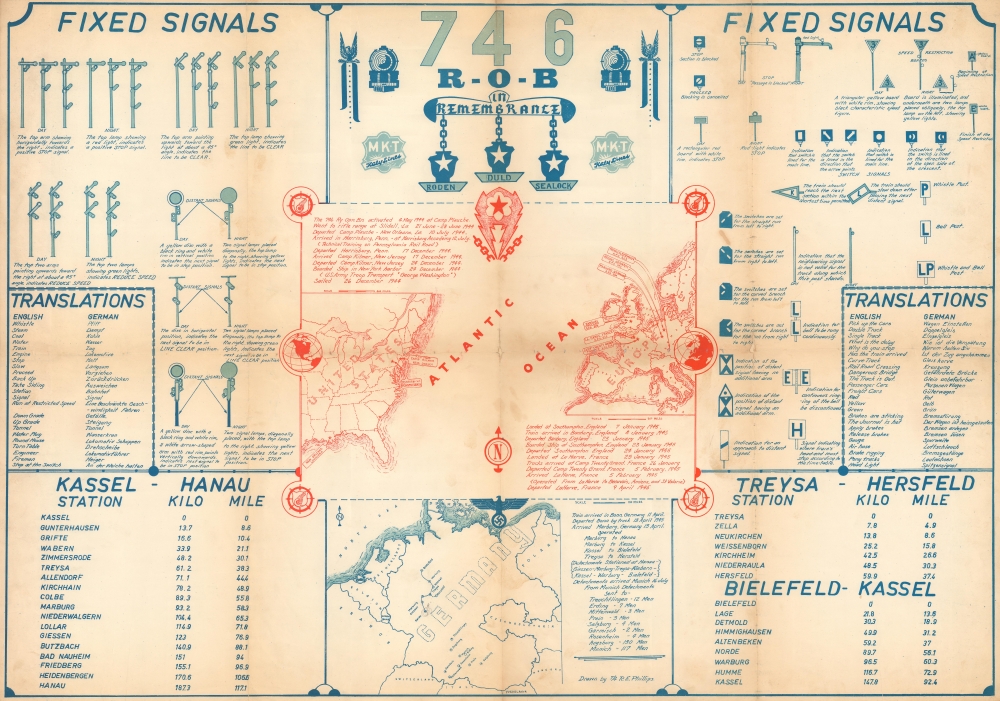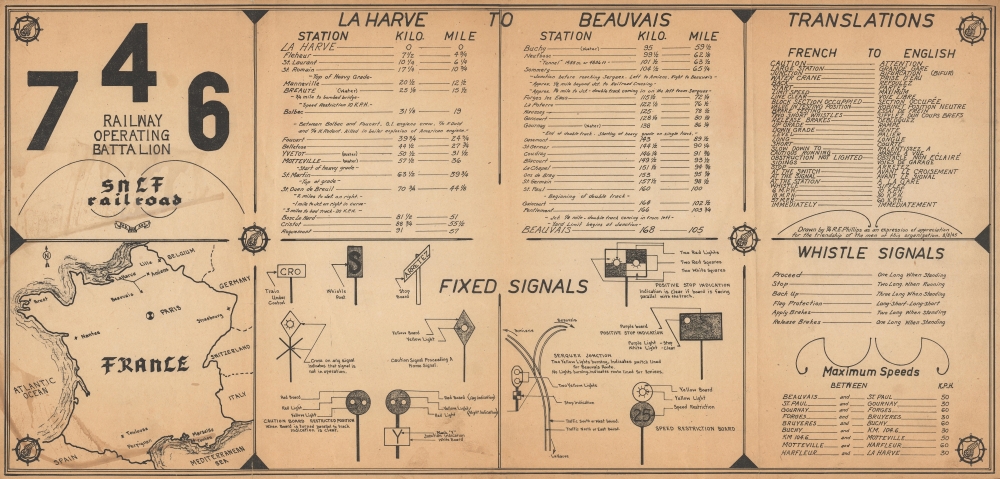This item has been sold, but you can get on the Waitlist to be notified if another example becomes available, or purchase a digital scan.
1945 Phillips WWII Route Maps of the 746th Railway Operating Battalion (Set of 2 Maps)
746ROB-phillips-1945$600.00

Title
746 R.O.B. / 746 Railway Operating Battalion SNCF Railroad.
1945 (dated) 27.5 x 39.5 in (69.85 x 100.33 cm) 1 : 5068800
1945 (dated) 27.5 x 39.5 in (69.85 x 100.33 cm) 1 : 5068800
Description
This is a set of 2 infographic maps by Richard E. Phillips detailing the 746th Railway Operating Battalion's involvement in World War II from its activation until the late summer of 1945. These pieces provide visual summaries of the battalion's time in France and Germany, including illustrating signals and providing translations for French and German words the battalion encountered.
The battalion moved into Germany on April 8, 1945. The route assigned to the 746th ran from Giessen north-northeast through Marburg, Treysa, and Kassel, before turning northwest to Warburg. The Battle of the Ruhr Pocket was raging at this time, and the 746th helped supply troops. This area also provided no standing coal reserves, so the 746th began mining their own coal at Frielendorf, making them, at the very least, one of the only, if not the only, railway battalions in the European Theater to operate a coal mine. The 746th was the first railway battalion to cross the and operate a railroad on the german side of the Rhine.
After the surrender, the battalion took over the Kassel-Bielefeld line and helped move prisoners of war and displaced persons, transport supplies, and redeploy units to the Pacific. On July 18, the 748th moved out of Kassel, and on the 19th, it began operations out of Munich. To quote from the 748th's unit history,
746 R.O.B.
The larger of the two sheets, the 746 R.O.B. (Railway Operating Battalion) piece provides information concerning the battalion's service in Germany and a short history from May 1944 - July 1945. A map at center marks the battalion's main stopping points, including New Orleans, Louisiana; Harrisburg, Pennsylvania; Camp Kilmer, New Jersey (where the battalion boarded a ship for Europe); Banbury, England; Le Havre, France; and Marburg, Kassel, and Munich, Germany. Insignia and small globes of the eastern and western hemispheres create a border. Below is a map of Germany that illustrates the 746th's theater of operation, including the line from Hanau to Bielefeld. The left and right sides feature diagrams of signals used on German railroads, explanations of each, translations of German words, and distance tables for the lines the 746th operated.746 Railway Operating Battalion SNCF Railroad
The sheet titled '746 Railway Operating Battalion SNCF Railroad' summarizes the battalion's operations in France. A map of France occupies the lower left. The railroad the battalion operated, which connected Le Havre to Amiens and Beauvais, is marked. A distance chart between Le Havre (La Harve here) and Beauvais provides distances in kilometers and miles all along the route. Illustrations explain French railroad signals and the meanings behind French whistles. A table of French-to-English translations is also provided.The Short History of the 746th Railway Operating Battalion
The 746th Railway Operating Battalion was activated at Camp Plauche, Louisiana, on May 4, 1944. The battalion was sponsored by the Missouri, Kansas and Texas Railroad (M.K.T., also known as 'The Katy'). It was the largest railway operating battalion to serve in World War II. The men learned to railroad 'the Army way' in Harrisburg, Pennsylvania, Chicago, Illinois, and New York City. The embarked for Europe on December 18, 1944. The battalion boarded the U.S.A.T. George Washington on December 24 and left New York Harbor on December 26, arriving at Southampton 15 days later. They arrived at Le Havre, France on January 25, 1945. From January 30, men from the battalion were scattered across France to serve with other Railway Operating Battalions. The rest of the battalion began operating a line 110 miles long between Beauvais and Le Havre, with detachments spread along the route. By the end of March, the battalion had reduced the running time between Le Havre and Creil to 9 hours, down from 18 before their arrival.The battalion moved into Germany on April 8, 1945. The route assigned to the 746th ran from Giessen north-northeast through Marburg, Treysa, and Kassel, before turning northwest to Warburg. The Battle of the Ruhr Pocket was raging at this time, and the 746th helped supply troops. This area also provided no standing coal reserves, so the 746th began mining their own coal at Frielendorf, making them, at the very least, one of the only, if not the only, railway battalions in the European Theater to operate a coal mine. The 746th was the first railway battalion to cross the and operate a railroad on the german side of the Rhine.
After the surrender, the battalion took over the Kassel-Bielefeld line and helped move prisoners of war and displaced persons, transport supplies, and redeploy units to the Pacific. On July 18, the 748th moved out of Kassel, and on the 19th, it began operations out of Munich. To quote from the 748th's unit history,
The newly assigned territory extended from Salzburg, Austria, on the east to Augsburg, Germany, on the west and from Mittenwald on the south to Treuchtlingen, Germany on the north.Men from the 746th began to be transferred to units returning to the U.S. in September, and passes and furloughs were given to those still in Europe. The 748th continued operating railroads in Germany and Austria until January 6, 1946, when the military government took over operations. This is where the battalion's official unit history ends.
Publication History and Census
Both maps were drawn by Technician fourth grade (T/4) Richard E. Phillips. The map titled 746 Railway Operating Battalion SNCF Railroad is dated 8/8/45. These are the only known cataloged examples of both maps.Condition
746 R.O.B. is in fair condition with wear along the original fold lines, very small areas of loss along the horizontal fold line, small areas of infill at two of the fold intersections, some soiling, and verso repairs to fold separations and measures 27.625 x 39.5 inches. / 746 Railway Operating Battalion SNCF Railroad is in good condition with light wear along the original fold lines, some soiling, and measures 13.27 x 27.75 inches.
References
746th Railway Operating Battalion 1944 - 1946, (Nuremberg) 1945.






